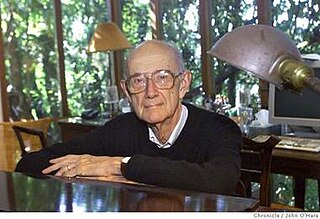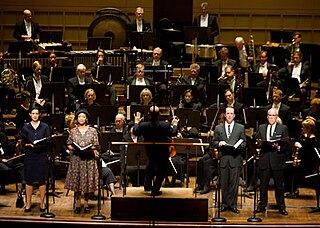The Grammy Award for Best Orchestral Performance has been awarded since 1959. There have been several minor changes to the name of the award over this time:

La mer, trois esquisses symphoniques pour orchestre, or simply La mer, L. 109, is an orchestral composition by the French composer Claude Debussy.

Andrew Welsh Imbrie was an American contemporary classical music composer and pianist.

Kent George Nagano is an American conductor and opera administrator. He is currently music director of the Montreal Symphony Orchestra since 2006, and general music director of the Hamburg State Opera since 2015.
Spirit Voices is a concerto for percussion and orchestra in seven movements by the American composer Steven Stucky. The work was jointly commissioned by the Singapore Symphony Orchestra and the Aspen Music Festival for percussionist Evelyn Glennie. It was first performed by soloist Evelyn Glennie the Singapore Symphony Orchestra under conductor Lan Shui November 14, 2003.
The Symphony by the American composer Steven Stucky is a four-movement symphony for orchestra. The work was jointly commissioned by the New York Philharmonic and the Los Angeles Philharmonic. It was composed from January through July 2012 and premiered September 28, 2012 at the Walt Disney Concert Hall in Los Angeles, with conductor Gustavo Dudamel leading the Los Angeles Philharmonic. The work had its New York City premiere November 29, 2012, with Alan Gilbert leading the New York Philharmonic.
The Second Concerto for Orchestra is a concerto for orchestra by the American composer Steven Stucky. The work was commissioned by the Los Angeles Philharmonic while Stucky was their composer-in-residence for the inaugural season of the Walt Disney Concert Hall. It was completed in 2003 and was first performed on March 12, 2004, with the conductor Esa-Pekka Salonen leading the Los Angeles Philharmonic. The piece was awarded the 2005 Pulitzer Prize for Music.
Rhapsodies for Orchestra is a single-movement orchestral composition by the American composer Steven Stucky. The work was jointly commissioned by the New York Philharmonic and the BBC for the Philharmonic's European tour in August and September 2008. The piece had its world premiere August 28, 2008 in Royal Albert Hall at The Proms, with the New York Philharmonic performing under conductor Lorin Maazel.
Radical Light is a single-movement orchestral composition by the American composer Steven Stucky. The work was commissioned by the Los Angeles Philharmonic with contributions from Lenore and Bernard Greenberg. It was premiered October 18, 2007 at the Walt Disney Concert Hall in Los Angeles, with conductor Esa-Pekka Salonen leading the Los Angeles Philharmonic. The title of the piece comes from the poem "He Held Radical Light" by A. R. Ammons.
Silent Spring is a 2011 symphonic poem for orchestra by the American composer Steven Stucky. The piece was written to commemorate the fiftieth anniversary of the environmental science book Silent Spring by Rachel Carson and was commissioned by the Pittsburgh Symphony Orchestra in collaboration with the Rachel Carson Institute at Chatham University. The work was premiered in Pittsburgh on February 17, 2012, with the Pittsburgh Symphony Orchestra conducted by Manfred Honeck.
Son et lumière is a symphonic poem by the American composer Steven Stucky. It was commissioned by the Baltimore Symphony Orchestra and composed between June and December 1988. The work was premiered in Baltimore by the Baltimore Symphony Orchestra under conductor David Zinman, May 18, 1989.
The Concerto for Orchestra is an orchestral composition in five movements by the American composer Jennifer Higdon. The work was commissioned by the Philadelphia Orchestra with contributions from the National Endowment for the Arts, the Philadelphia Music Project, and Peter Benoliel. It was premiered at the Kimmel Center for the Performing Arts in Philadelphia June 12, 2002, with conductor Wolfgang Sawallisch leading the Philadelphia Orchestra.
Pinturas de Tamayo is an orchestral composition in five movements by the American composer Steven Stucky. The work was commissioned by the Chicago Symphony Orchestra, who premiered the work on March 28, 1996, under the conductor Michael Gielen in Symphony Center, Chicago. The piece is inspired by the paintings of the Mexican artist Rufino Tamayo.
Fanfare Ritmico is a single-movement orchestral composition by the American composer Jennifer Higdon. The work was commissioned by The Women's Philharmonic as part of The Fanfares Project. It was given its world premiere in March 2000 by conductor Apo Hsu and the Women's Philharmonic.
The Stars and the Roses is a three-movement composition for tenor solo and orchestra set to the poetry of Czesław Miłosz by the American composer Steven Stucky. The work was commissioned by the Berkeley Symphony, for which Stucky was then composer-in-residence. It was first performed on March 28, 2013 by the tenor Noah Stewart and the Berkeley Symphony under the conductor Joana Carneiro. The work was rewritten by Stucky in a chamber arrangement of the piece that premiered on October 18, 2013 by the Curtis 20/21 Contemporary Music Ensemble and tenor Roy Hage. The piece is dedicated to Stucky's wife Kristen.
Kenneth Kiesler is an American symphony orchestra and opera conductor and mentor to conductors. Kiesler is conductor laureate of the Illinois Symphony Orchestra where he was music director from 1980 to 2000 and founder and director of the Conductors Retreat at Medomak. In 2014, Kiesler was nominated for a Grammy Award for his recording of Darius Milhaud’s opera L’Orestie d’Eschyle. He is Director of Orchestras and Professor of Conducting at the University of Michigan.
True Fire is a song cycle for solo baritone and orchestra by the Finnish composer Kaija Saariaho. The work was jointly commissioned by the Los Angeles Philharmonic, the NDR Symphony Orchestra, the BBC Symphony Orchestra and the Orchestre National de France. It was first performed at the Walt Disney Concert Hall in Los Angeles on May 14, 2015, by the baritone Gerald Finley and Los Angeles Philharmonic under the conductor Gustavo Dudamel. The piece is dedicated to Gerald Finley.
Notes on Light is a cello concerto by the Finnish composer Kaija Saariaho. The work was commissioned by the Boston Symphony Orchestra and was first performed at Symphony Hall, Boston on February 22, 2007, by the cellist Anssi Karttunen and the Boston Symphony Orchestra under the conductor Jukka-Pekka Saraste.
The Oboe Concerto is a composition for solo oboe and orchestra by the American composer John Harbison. The work was commissioned by the San Francisco Symphony for its principal oboist William Bennett. It was completed on October 18, 1991, and was given its world premiere by Bennett and the San Francisco Symphony under the conductor Herbert Blomstedt in 1992.








